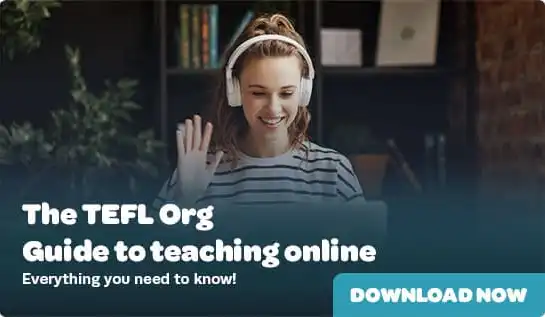| Company | Hourly rate | Degree required | Lessons provided | Students | Min. hours per week | TEFL qualification required | Accepts non-native speakers | Previous teaching experience required? | Additional requirements | Application link |
|---|---|---|---|---|---|---|---|---|---|---|
| 51Talk |
£14 - £17 ($18 - $22) | Young Learners | 10 | Yes | Apply | |||||
| AmazingTalker |
£12.62 - £78.87 ($16 - $100) | All ages | None | 1 year | Apply | |||||
| Cafetalk |
£8 - £22 ($10 - $28) | Adults | None | None | None | Apply | ||||
| Cambly |
£7.65 ($10.20) | All ages | None | None | None | Apply | ||||
| English First |
From £9.50 (From $11.85) | All ages | None | None | Teachers must live and work in the UK or the USA | |||||
| English Hunt |
£10.50 ($14.50) | All ages | 10 | 4 years | Must be US citizen | Apply | ||||
| Engoo |
£2 - £7.20 ($2.80 - $10) | All ages | None | Preferred | None | Apply | ||||
| FluentBe |
£7.20 - £8.70 ($10 - $12) | All ages | None | 1 Year | Apply | |||||
| Italki* |
Set your own hourly rate | All ages | None | Preferred | None | Apply | ||||
| Latin Hire |
£5 - £9.50 ($7 - $13) | All ages | 5 | 1 year | Elementary level Spanish or Portuguese required | Apply |
- TEFL Courses TEFL Courses
- View all TEFL courses
- 120-hour Premier Online TEFL Course
- 250-hour Level-5 Online TEFL Course
- Online TEFL Courses
- Classroom TEFL Courses
- Combined TEFL Courses
- Virtual TEFL Courses
- TEFL Course Bundles NEW
- Advanced TEFL Courses
- TEFL Lesson Plans & Resources
- TEFL Gift Vouchers
- Which TEFL course is right for you?

- New to TEFL New to TEFL
- Locations
- TEFL Jobs
- Teach Abroad Teach Abroad
- Teach English Abroad
- Teach English in Japan
- Teach English in South Korea
- Teach English in Spain
- Teach English in China
- TEFL Salaries Abroad
- Requirements for teaching abroad
- Teach English abroad without a degree
- How to find teaching jobs abroad without experience
- Can you teach English abroad as a non-native speaker?

- Teach Online
- About Us
- Blog
- Podcast
Teach English Online to Mexican Students
How do you teach English online to Mexican students? Here’s our guide to finding teaching work with a truly engaged, exciting audience.


TEFL course provider
TEFL certificate
teachers trained
find work within 2 months
With a strong student base catered to by so many online English teaching companies and platforms, teaching English online to Mexican students is a great opportunity. A country with considerable interest in learning English, Mexico has substantial educational prestige and an extremely large population of around 128 million people.
Literacy rates are high, access to the Internet is widely available, and English is taught in Mexican schools from the secondary school level. Yet, English proficiency rates aren’t as high as you might expect. Mexico’s level of English proficiency is average despite the country’s proximity to massive English-speaking countries in the form of the USA and Canada.
Still, the facilities are there, and the demand is high. Online teachers could do far worse than zeroing in on Mexico. So, what do you need beyond English language skills and a solid internet connection? Does an online teacher need a bachelor’s degree? Years of online teaching experience? Can anyone do it?
Let’s take a look at teaching English online to students from Mexico.
Requirements for teaching English online to Mexican students
So you’re keen to learn more about Mexican culture and eager to connect with Mexican students through teaching English online. Which qualifications do you need to get started?
A crucial point: online teaching platforms and language schools have varying requirements. Still, there are some common trends in the industry. Let's take a deep dive into the essential qualifications you need for an invigorating career in online English teaching.Degree
There’s no point denying that a bachelor's degree, particularly in English, Education, or a related field, can be extremely advantageous. For some English teaching companies, it’s essential. However, it's not always a strict requirement. Many online companies are flexible about degrees. Online teaching platforms, meanwhile, let students choose whether they need a tutor who has a degree or not.
TEFL certification
A TEFL certificate is highly recommended for anyone aspiring to teach English online. A 120-hour TEFL course is the industry standard. Advanced TEFL certification is particularly beneficial for teaching Mexican students, given the specific learning objectives of many adult learners. Specifically, there will be plenty of university students requiring online lessons in English for Academic Purposes and professionals requiring Business English lessons - meaning an advanced qualification in Business English would make you attractive to online students.
Native/non-native speaker
Can you teach English online to Mexican students as a non-native speaker? Of course! Both native and non-native English speakers can find opportunities to teach English online to Mexican students. Evidence of fluency through tests like the IELTS or TOEFL can be crucial for job applications if you’re a non-native English speaker. Alternatively, if you hold a bachelor’s degree from an English-speaking institution, that should be enough to demonstrate fluency in English.
Download our teaching English online guide
Online platforms for teaching Mexican students
Teaching methods for Mexican students
When you’re teaching Mexican students online, you will want to know the best methods for improving vocabulary, pronunciation and overall proficiency. Whether you have prior teaching experience or not, every English teacher will tell you that each student is different and requires different methods of teaching English.
Here are some tips for teaching Mexican English learners that can work wonders.
Language immersion
One of the best ways to improve English proficiency is to create an environment in your lessons where students feel immersed in the English language. This can involve role-playing exercises in which students play different characters. Total physical response (TPR) is another immersive technique in which teachers give physical instructions to students (think ‘Simon Says’!). Using audio like music or podcasts in the classroom is also extremely effective in immersing your students in English, especially if they’re more advanced.
Challenges of teaching English online to Mexican students
You have a TEFL certificate. Ideally, you have a stable internet connection, and you meet the minimum requirements for a range of English teaching companies and platforms - so what else do you need to consider?
When you teach English to Mexican students as a second language, you might encounter some challenges. Some are common, and others are specific to teaching online classes to Mexican students.
Let’s get into more detail.

Language barriers
It’s important to note that if you’re not from Mexico and you learned Spanish at school, it’s unlikely to have been Mexican Spanish that you were taught. Mexican Spanish differs in many ways from “Standard” Spanish, so even if you are proficient in the latter, it doesn’t necessarily mean you’ll be easily understood by Mexican students.
So, what’s the answer? Try to engulf yourself in Mexican language media before you take on online lessons with Mexican students. Note the subtle and obvious differences between Mexican Spanish and what you’ve learned, and make sure you’re using the version of Spanish that’s relevant to your students.
Technical issues
Ultimately, technical issues will rear their ugly heads when online lessons occur. The best you can do, as a foreign language teacher, is make sure your tech all works. A stable internet connection is the least you need. Having a quality microphone, webcam, a computer with up-to-date software, and even a decent pair of headphones are all incredibly helpful.
Your students, on the other hand, can’t all be expected to have the best of the best, so it’s important to try to mitigate technical issues. Remember to remain calm and adaptable. If a student misses part of a lesson due to a bad connection, you can always set them homework for next time. You can also plan your lessons according to the hierarchy of needs and make sure the most important parts of your lesson are always covered.
Always plan for technical issues, regardless of your online audience, because these things happen!

Scheduling and time zone differences
Mexico has four different time zones. That can make things tricky when you’re planning lessons, so try to bear that in mind. Here’s a quick guide to the time zones in Mexico, and you’re going to want to refer to this map:
In Baja California, in the far west, bordering the US state of California and the Pacific Ocean, Pacific Standard Time (Zona Noroeste) is used. In the very far east, in the state of Quintana Roo, Eastern Standard Time (Zona Sureste) is used.
Most of Mexico is covered by two time zones. The central part of the country, along with most eastern parts, uses Central Standard Time (Zona Centro). This includes Mexico City and most of the state of Chihuahua. Western Mexico, including the states of Sonora, Sinaloa, and Jalisco, uses Mountain Standard Time (Zona Pacifico).
Tips for success
What do you need to make the most of your online teaching job working with Mexican students? Here’s what we think English teachers working with a Mexican student base need to know about.
Understand Mexican culture
If you’re keen to appeal to a certain student base, you must understand them and their needs. What specific English vocabulary do business professionals in Mexico need to know? For adult students, which kind of lessons are required to progress in particular occupations or achieve specific educational goals? Online English teachers working with young learners need to know what the schooling system is like, what English lessons are like in Mexico, and what kind of tutoring they’ll need.
Beyond that, understanding Mexican culture is important. Cultural awareness and sensitivity are integral to building connections with your students, whether you teach online or in the classroom. A lot of the time, you don’t need a bachelor’s degree to teach English online to Mexican students, but you will need a comprehensive understanding of Mexican people and what makes them tick in order to give a truly great online teaching experience.
Frequently Asked Questions
Q. Do I need to speak Spanish to teach English online in Mexico?
It’s not vital to speak Spanish when you’re teaching English online to Mexican students, but it can help. Bear in mind that Mexican Spanish is its own distinct language.
Q. What is the average pay for online English teachers in Mexico?
The hourly rate you can earn as an online English teacher working with students from Mexico and Latin America depends on the online English teaching companies or platforms you work with.
Q. What are the best platforms to find online students from Mexico?
If you’re keen to teach English online to Mexican students, there are loads of great platforms and online English teaching companies to choose from. LatinHire, Preply, iTalki, Lingoda and loads of others cater to students from Mexico and all over Latin America.











